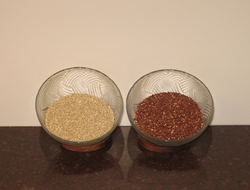Quinoa
Published: June 17, 2022
Quinoa has become a preferred choice of "grain" for many people because of its relatively high and complete protein content.
Botanically, quinoa is not a grain and costs considerably more than true grains such as rice, wheat, corn, and barley.
As a source of protein how does quinoa, considered by some to be a "superfood", compare not only with grains, but also with salmon.
What is quinoa?
Quinoa, because of its grain-like appearance,is often referred to as a pseudo-grain or pseudo-cereal.
Botanically, quinoa belongs to the species Chenopodium or goosefoot. Grains such as wheat and barley belong to the true grass family.
The species Chenopodium is closely related to plants such as beets, spinach and tumbleweeds.
Quinoa granules are the edible seeds of the dicotyledonus annual which grows to between 1 and 2 metres high.
The plants are usually self pollinating producing green flowers and fruits of a variety of colours (black, white and red) depending on the cultivar. The leaves of the quinoa plant are also edible.
Nutrition
When compared to other grains (brown rice, whole wheat pasta, barley, and wild rice) the equivalent amount of quinoa (1/2 cup) provides more:
- energy, protein, total fat and omega-3 and 6 fatty acids
- vitamins B1 and B2, vitamin E, and folate
- calcium, copper, iron, magnesium, phosphorus, potassium, and sodium
- choline
However, quinoa has the lowest values...link to the full article to learn more.
References
1.
http://en.wikipedia.org/wiki/Quinoa
2.
Whitney, E. & Rady Rolfes, S. (2005). Understanding Nutrition. Belmont, CA: Thomson Wadsworth
3.
Gropper, S.S., Smith, J.L. & Groff, J.L. (2005). Advanced Nutrition and Human Metabolism (4thEd.). Belmont, CA: Thomson Wadsworth.

